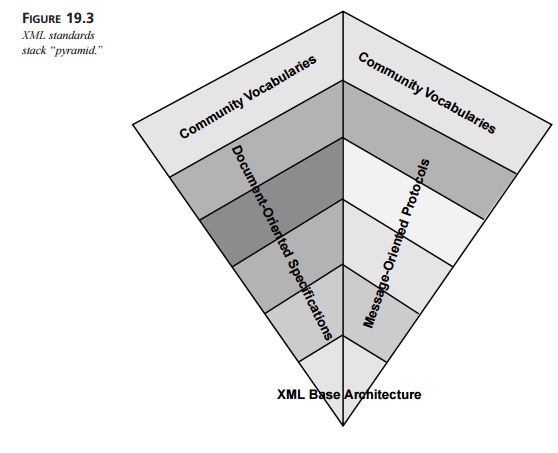Chapter: XML and Web Services : Applied XML : Understanding XML Standards
Community Vocabularies Layer
Community Vocabularies Layer
As you’ve probably noticed, we’ve spoken about every part of the XML
standards stack except for one: the Community Vocabularies layer. On top of all
these various layers and aspects sits the Community Vocabularies layer. This is
the layer where all the industry-specific implementations and problem-oriented
specifications are created. In effect, this is where the “rubber meets the
road.” Community vocabularies, which can be vertical industry specifications
and standards or cross-industry specifications, make use of all or some of the
aforementioned technologies and specification layers to accomplish their goals.
Community vocabularies specify the actual metadata and information that
represents how a given user community plans to make use of XML. These community
vocabularies may represent a need in an industry, such as insurance or
electronic component manufactur-ing, or a horizontal user community, such as
online gaming or data warehousing. In any case, the vocabularies define the
specifics of data interchange that can then be repre-sented using Process layer
specifications, utilizing Service layer components, packaged into Message layer
messages, transmitted over Transport layer protocols, and utilizing any
combination of security, presentation, query, and semantics aspects. Thus, the
com-munity vocabulary forms the top layer.
Although community vocabularies represent the absolute top of the XML
standards stack, they often are some of the first specifications to be
developed. The reason for this is quite simple: Some need motivated the desire
to implement XML in the
first place! In many cases, this was a desire to communicate between
industry partici-pants, such as in the financial services, manufacturing, or
healthcare arenas. However, when it came time to implement these
specifications, the various specification-writing bodies realized that some of
their required pieces of functionality, as represented by the
messaging-oriented protocol or document-oriented specification stack, didn’t
exist. The result was that industry-specific vocabularies had to define
specifications that were of a more general nature. For example, the ACORD
specification had many Message layer components defined in its early days. As
layers of the XML stack become increasingly more developed, the breadth of
individual community vocabulary specifications become increasingly more narrow.
However, while the scope of community vocabularies may be increasingly
more focused as other layers of the stack become more developed, the number of
community vocabu-laries are proliferating. There’s a vast number of vertical
industries and horizontal user communities that desire to define their own,
specific XML vocabularies for interchange. In fact, the entire XML standards
stack in actuality looks more like an upside-down pyramid when viewed from the
perspective of how many different specifications there are in a given level.
Whereas there are hundreds, if not thousands, of individual commu-nity
vocabulary specifications at the top level, there are very few specifications
at the XML Base Architecture layer, and the number increases as we move up the
XML specification food chain. One may say that document-oriented specifications
remain steady in number, but it can still be argued that the number of
document-oriented specifi-cations is greater than the number XML base
architecture specifications and less than the number of community vocabulary
implementations. Therefore, we have an inverse pyramid of usage, as shown in
Figure 19.3, that helps to make our XML standards stack model even more
accurate.

Related Topics